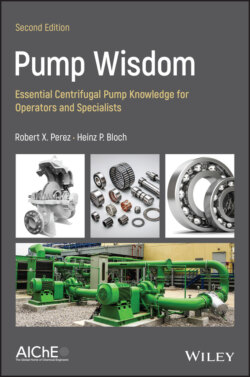Читать книгу Pump Wisdom - Robert X. Perez - Страница 12
Pump Performance: Head and Flow
ОглавлениеPump performance is always described in terms of head H produced at a given flow capability Q, and hydraulic efficiency η attained at any particular intersection of H and Q. Head is customarily plotted on the vertical scale or vertical axis (the left of the two y‐axes) of Figure 1.4; it is expressed in feet (or meters). Hydraulic efficiency is often plotted on another vertical scale, the right of the two vertical scales, i.e. the y‐axis in this generalized plot.
Figure 1.2 Typical process pump with suction flow entering horizontally and vertically oriented discharge pipe leaving the casing tangentially.
Source: Emile Egger & Cie. [2].
Head is related to the difference between discharge pressure and suction pressure at the respective pump nozzles. Head is a simple concept, but this is where consideration of the impeller tip speed is important. The higher the shaft rpm and the larger the impeller diameter, the higher will be the impeller tip speed – actually its peripheral velocity.
Figure 1.3 A semiopen impeller with five vanes. As shown, the impeller is configured for counterclockwise rotation about a centerline “A.”
Figure 1.4 Typical “H–Q” performance curves are sloped as shown here. The best efficiency point (BEP) is marked with a small triangle; power and other parameters are often displayed on the same plot.
The concept of head can be visualized by thinking of a vertical pipe bolted to the outlet (the discharge nozzle) of a pump. In this imaginary pipe, a column of fluid would rise to a height “H”. If the vertical pipe would be attached to the discharge nozzle of a pump with higher impeller tip speed, the fluid would rise to a greater height “H+”. It is important to note that the height of a column of liquid, H or H+, is a function only of the impeller tip speed. The specific gravity of the liquid affects power demand but does not influence either H or H+. However, the resulting discharge pressure does depend on the liquid density (specific gravity or Sp.G.). For water (with an Sp.G. of 1.0), an H of 2.31 ft equals 1 psi (pound‐per‐square‐inch), while for alcohol, which might have a Sp.G. of 0.5, a column height or head H of 4.62 ft equals 1 psi. So if a certain fluid had an Sp.G. of 1.28, a column height (head H) of 2.31/1.28 = 1.8 ft would equal a pressure of 1 psi.
For reasons of material strength and reasonably priced metallurgy, one usually limits the head per stage to about 700 ft. This is a fairly important rule‐of‐thumb limit to remember. When too many similar rule‐of‐thumb limits combine, one cannot expect pump reliability to be at its highest. As an example, say a particular impeller‐to‐shaft fit is to have 0.0002–0.0015 in. clearance on average size impeller hubs. With a clearance fit of 0.0015 in., one might anticipate a somewhat greater failure risk if this upper limit were found on an impeller operating with maximum allowable diameter.
On Figure 1.4, the point of zero flow (where the curve intersects the y‐axis) is called the shut‐off point. The point at which operating efficiency is at a peak is called the best efficiency point, or BEP. Head rise from BEP to shut‐off is often chosen around 10–15% of differential head. This choice makes it easy to modulate pump flow by adjusting control valve open area based on monitoring pressure. Pumps “operate on their curves” and knowledge of what pressure relates to what flow allows technicians to program control loops.
The generalized depictions in Figure 1.4 also contain a curve labeled NPSHr, which stands for Net Positive Suction Head required. This is the head of liquid that must exist at the edge of the inlet vanes of an impeller to allow liquid transport without causing undue vaporization. It is a function of impeller geometry and size and is determined by factory testing. NPSHr can range from a few feet to a three‐digit number. At all times, the head of liquid available at the impeller inlet (NPSHa) must exceed the required NPSHr.
